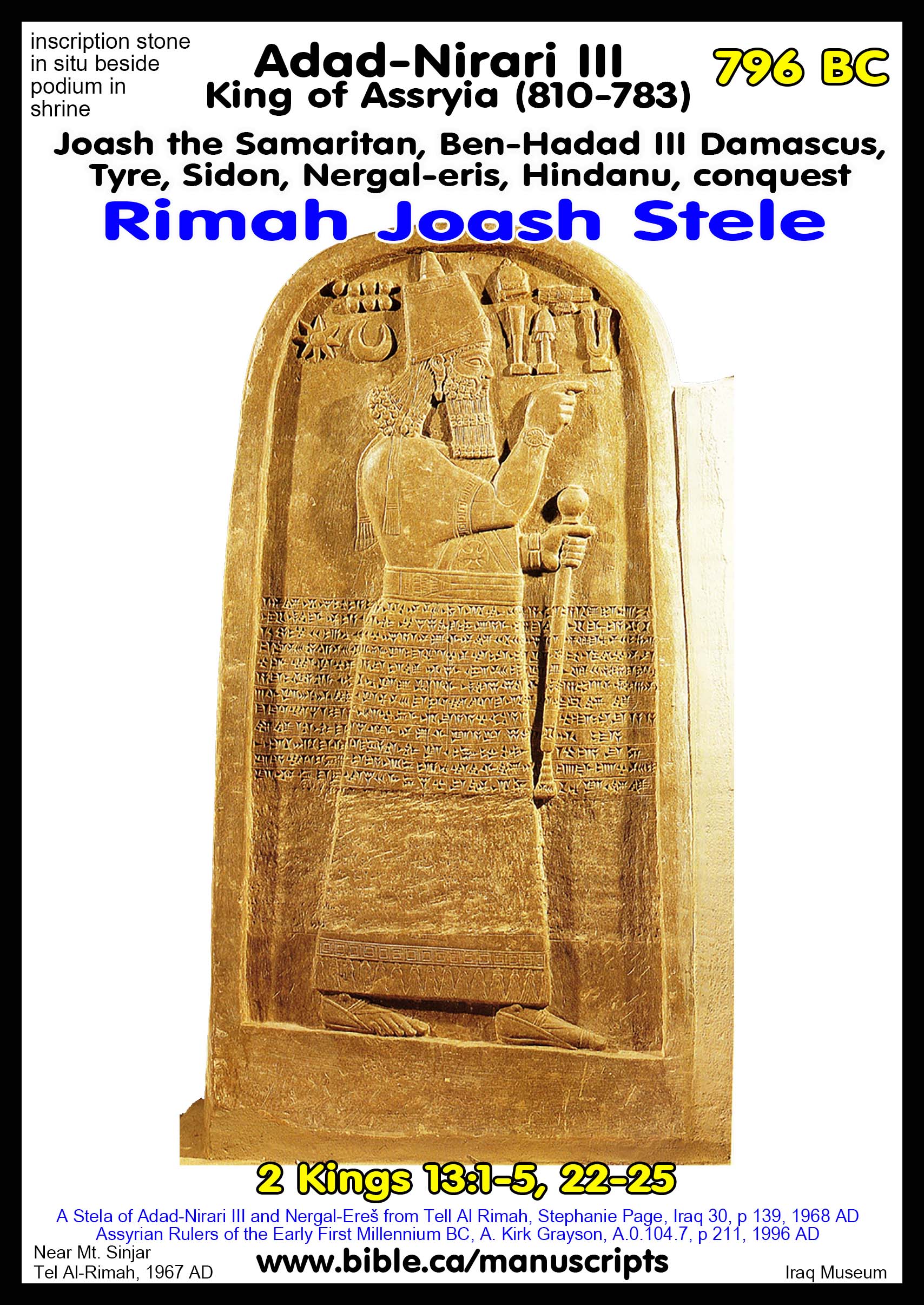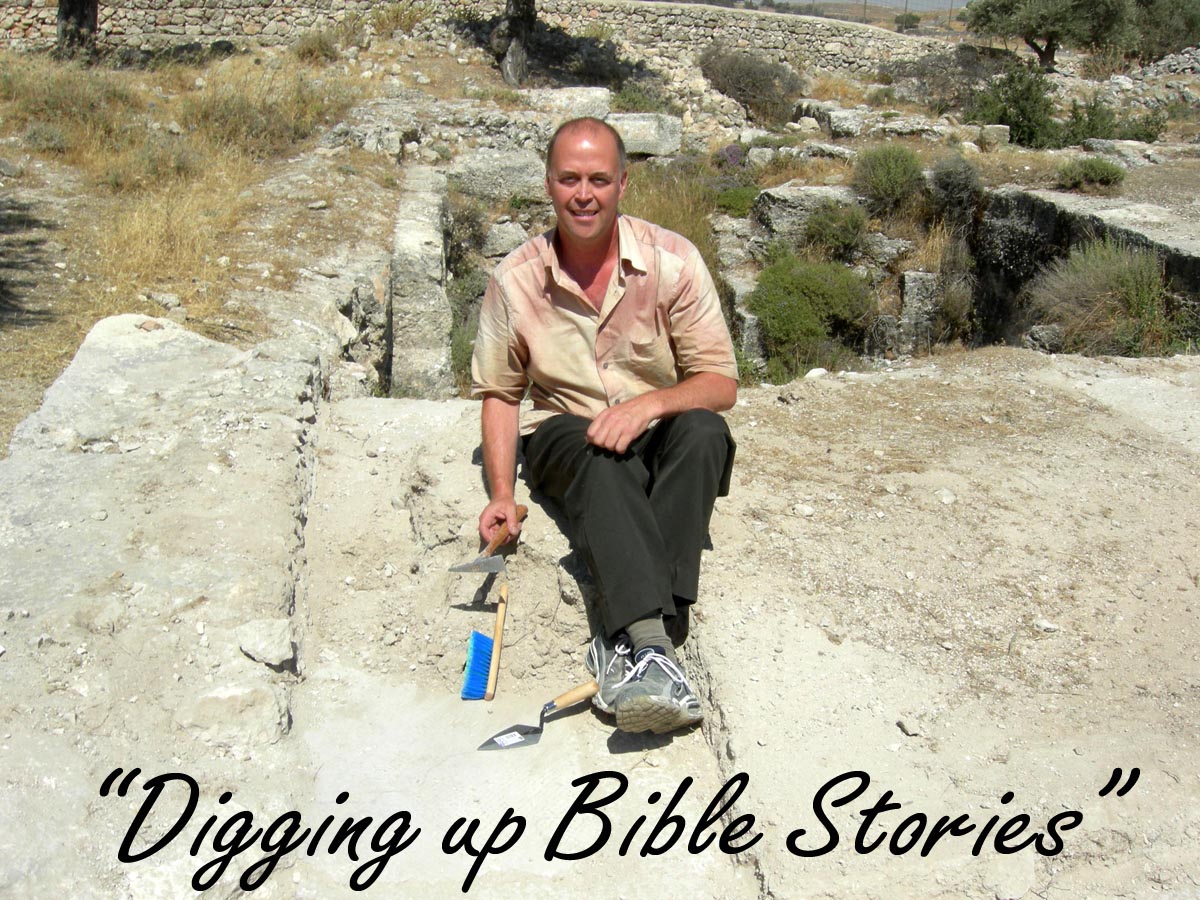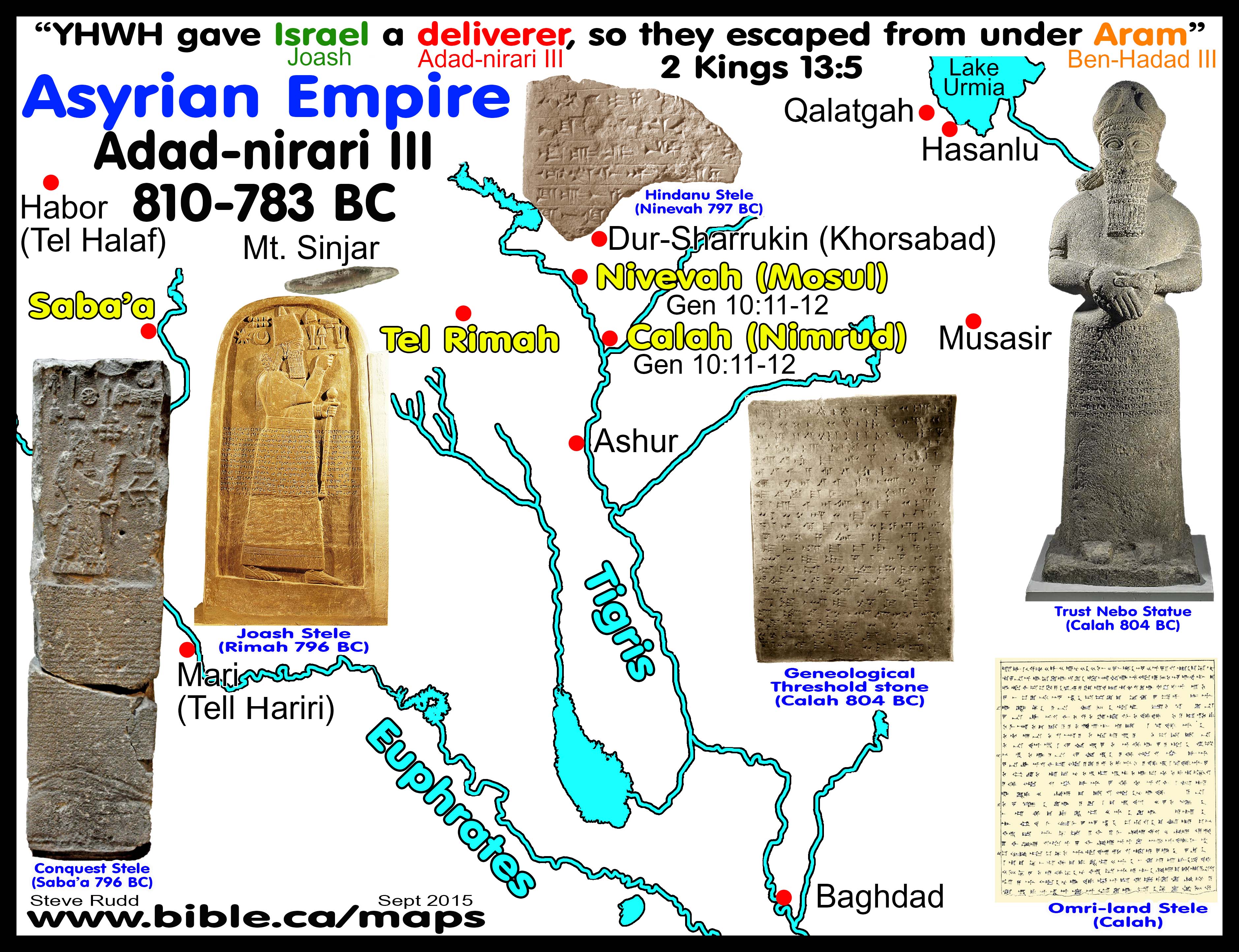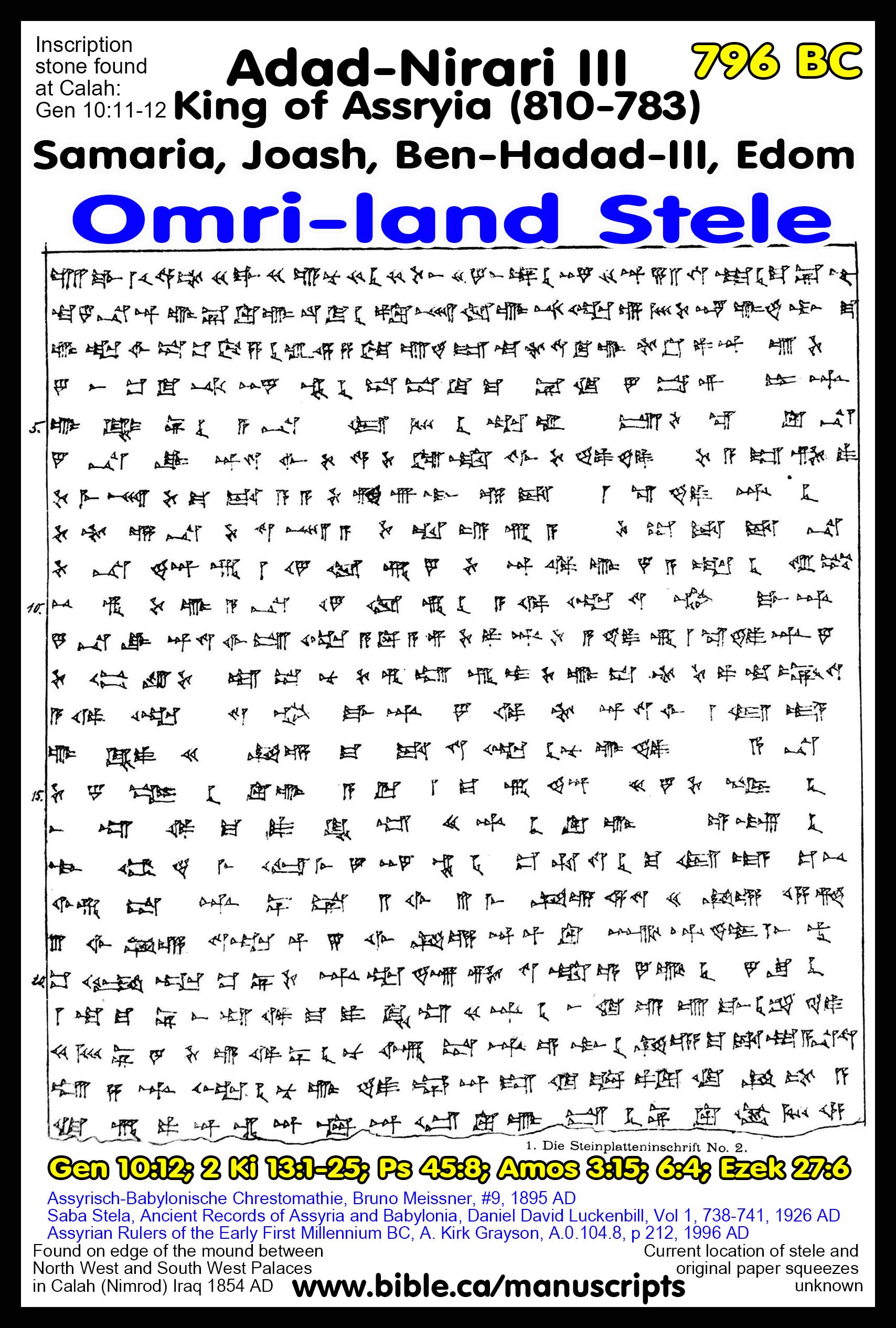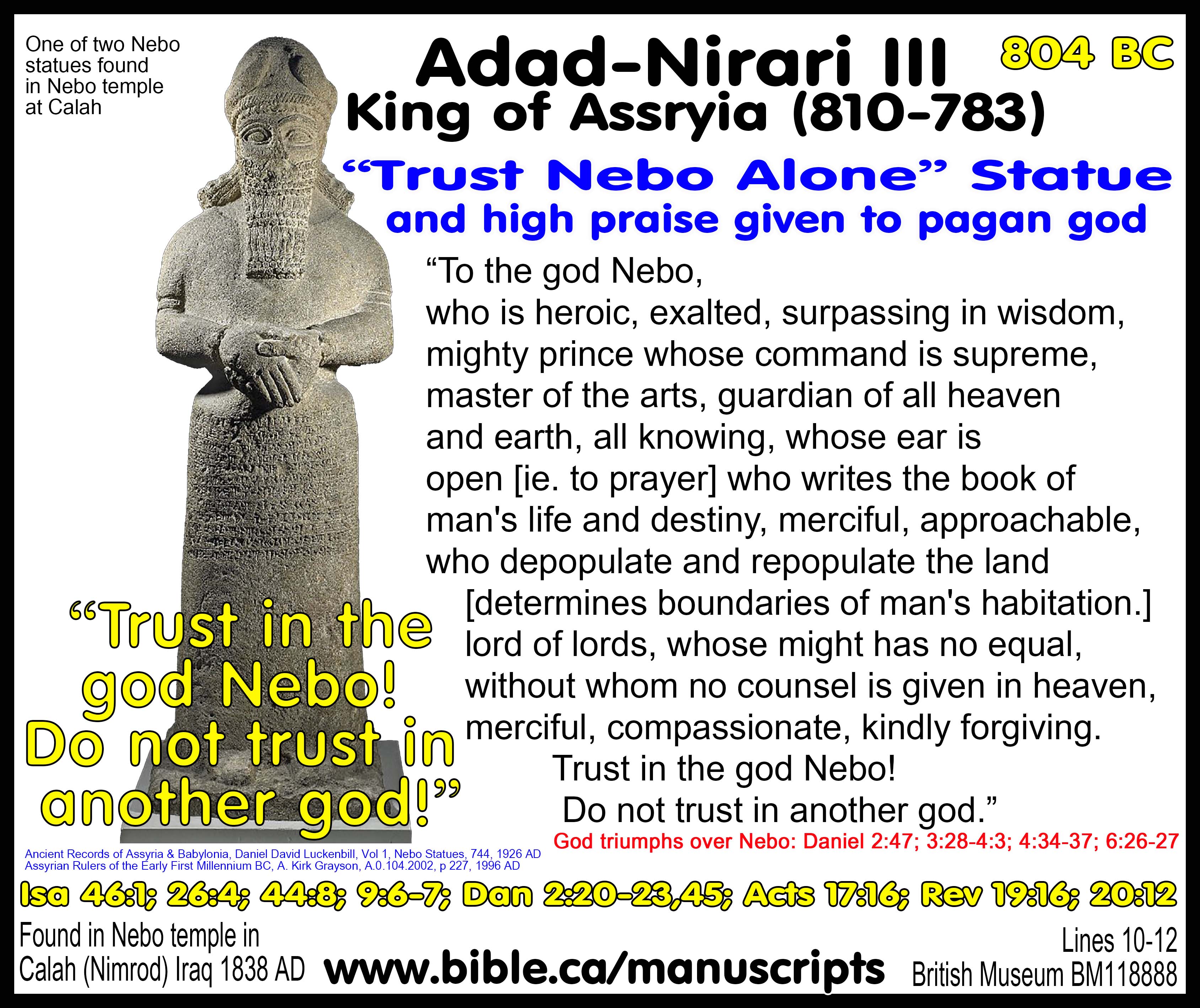Adad-Nirari III, King of Assyria (810-783)
"Al Rimah Joash Conquest Stele" 796 BC: "Tribute from Joash the Samaritan" 2 Kings 13:1-5; 22-25
|
Adad-Nirari III (810 - 783 BC) "The unknown deliverer" |
||
|
2 Kings 13:5 |
||
|
"YHWH gave Israel King Jehoahaz & Joash (Israel) |
a deliverer King Adad-nirari III (Assyria) |
they escaped Aram" King Ben Hadad III (Aram) |
Summary of conquests of Adad-nirari III in 796 BC that name Joash (Jehoash) the Samaritan, Ben-Hadad III, Tyre, Sidon, Nergal-eris, Hindanu: 2 Kings 13:5
|
Al Rimah Joash Conquest Stele of Adad-nirari III: 796 BC
"To the god Adad, son of the god Anu, Adad-narari [III], king of Assyria, son of Samsi-Adad (V), son of Shalmaneser (III), I mustered my chariotry, troops, army. In one year I subdued the entire Amurru [Turkey] & Hatti [Syria, Israel]. I imposed tax & tribute of Mari [Ben-Hadad III], the Damascene. I received the tribute of Joash (Iu'asu), the Samaritan, (and) of the people of Tyre (and) Sidon. … At that time I decreed for Nergal-eris, governor, the land of Hindanu." (Adad-Nirari III, Tel Al-Rimah Stele, 796 BC) |
|
Digging up Bible stories! The Rimah Joash conquest stele confirms the story of where God delivered Israel out of the hand of Ben-Hadad III (son of Hazael), king of Aram in 2 Kings 13:5.
God sent Israel (Jehoahaz and Joash, Samaria) a deliverer (Adad-nirari III, Assyria) they escaped Aram (Ben Hadad III, Aram)
Detailed outline on Adad-Nirari III "What we read in the book, we find in the ground" |
Introduction:
- The Rimah Joash Stele tells the exact story found in the Bible: 2 Kings 13:1-5; 24-25 that dates to 796 BC
- First, Jehoahaz king of Israel was delivered in 799 BC by the unknown deliverer (Adad-Nirari III) from under the bondage of Ben-Hadad III of Aram.
- Second, Joash king of Israel was delivered in 796 BC by this same unknown deliverer (Adad-Nirari III).
- The process took a few years but by 796 BC Ben-Hadad III was under the complete control of Assyria, who extracted tribute from Joash king of Israel in exchange for peace.
- The Rimah Joash Stele (with the help of the Saba'a Stele and Hindanu Stele) confirms the Bible as true history!
- Infant Adad-nirari III coregent with his mother Semiramis:
- Young Adad-nirari III becomes king of Assyria but his mother “Semiramis” is coregent with him for 6 years.
- We do not know how old he was when he became king, but the dynastic father son transmission of kings was as strong in Assyria as it was in Judah.
- Here we have two kings (Joash of Judah and Adad-nirari III) who ascended the throne as infants while their mothers (Athaliah, Semiramis) ruled the kingdom for them for 6 years.
- What is even more amazing is that they were king at the same period of time with an overlapping governorship of 14 years.
- This may have created an affinity between the Hebrews and Assyria as the two child kings governed their parts of the world at the same time.
- Joash king of Judah and Adad-nirari III were:
a. Both Infants when their fathers died
b. Both had coregent mothers (Athaliah, Semiramis)
c. Both had coregencies of 6 years
4. Summary of Adad-Nirari III’s reign:
a. Six-year coregency with mother “Semiramis”: 810-806 BC
b. First functioning year as sole monarch: 806 BC
c. 5th year of reign as sole monarch on Stele: 799 BC
d. 4 year Fulfilment of 2 Ki 13:5: 799 BC (Jehoahaz/Israel) - 796 BC (Joash/Israel)
e. Dies and his son Shalmaneser IV becomes king of Assyria
- About the two Israeli kings:
- Jehoahaz king of Israel 814-798 BC was made the promise of the deliverer in 2 Ki 13:5
- Joash (Jehoash) was king of Israel 798-782 BC who had continued back and forth warfare with Ben-hadad III, king of Aram (son of Hazael).
- Three times Joash defeated Ben-hadad III, each time recovering the cities and territories of Samaria
- First: 796 BC: Hazael, Ben-Hadad III's father, had taken the land of Samaria but when Hazael died, Joash took back the land from his son Ben-hadad III. This is in 796 BC when God sent a "deliverer" (Adad-nirari III, king of Assyria) "Then Jehoahaz entreated the favor of the Lord, and the Lord listened to him; for He saw the oppression of Israel, how the king of Aram oppressed them. The Lord gave Israel a deliverer, so that they escaped from under the hand of the Arameans; and the sons of Israel lived in their tents as formerly." (2 Kings 13:4–5)
- Second: Ben-hadad III attacks and recaptures Samaria for a time, but Joash goes to war and recaptures it a second time.
- Third: Ben-hadad III recaptures Samaria and Joash recovers it third time.
- It is the first deliverance of Samaria in 796 BC by Adad-nirari III, king of Assyria that is recorded on these archeological stela:
- The Bible story of God saving Israel from Syrian through Adad-Nirair in 797 BC: 2 Kings 13:4-5
- Adad-nirari III is specifically but indirectly referenced in 2 Kings 13:5 as the "deliverer" sent by God to save Israel from Damascus.
- The entire story is told here: 2 Kings 13:1-5; 24-25
- The Saba'a Stele (with the help of the Hindanu Stele) confirms the Bible as true history!
- "Thereafter, Hazael savagely attacked Israel under Jehu, seizing Transjordan (2 Ki. 10:32–33), and throughout the reign of Jehoahaz, c. 814/3–798 bc (2 Ki. 13:22). But temporary relief did occur; the ‘deliverer’ sent by God then (2 Ki. 13:5) may have been Adad-nirari III of Assyria who intervened against Hazael" (The New Bible Dictionary, p 67, 1996 AD)
- What you read in the book you find in the ground!
I. About the Rimah Conquest Stele: 796 BC
- The Al-Rimah "Joash" stele is catalogued by Grayson #7: Assyrian Rulers of the Early First Millennium BC, A. Kirk Grayson, A.0.104.7, p 211, 1996 AD
- "The Al-Rimah stele found in 1967 contains a reference to “Joash, the Samarian” (compare 2 Kgs 13:10) and allows for the possibility that Adad-Nirari III was the unnamed “savior” of Israel mentioned in 2 Kgs 13:5." (Lexham Bible Dictionary, Adad-Nirari III, 2015 AD)
- "The stele was discovered in an excellent state of preservation and is now in the Iraq Museum. It measures 130 cm in height and 69 cm in width at the base. The inscription has been collated from the published photos. The erased portion (lines 13-21) is very difficult to decipher from the photos and most readings must be regarded as uncertain, In particular there is uncertainty about the numerals preceding kapranisu; I have followed Page's decipherment, which, as she states, is based on reaching the correct total in line 20." (Assyrian Rulers of the Early First Millennium BC, Adad-Nirari III, Tel Al-Rimah Stele, A.0.104.7, A. Kirk Grayson, p 210, 1996 AD)
- Archeological excavation dig report was written by Stephanie Page: A Stela of Adad-Nirari III and Nergal-Ereš from Tell Al Rimah, Stephanie Page, Iraq 30, p 139-153, 1968 AD.
- "The stela was discovered at Tell al Rimah where it stood in ‘position inside the cella of a Late Assyrian shrine, set beside the podium, a placing that is unparalleled among the find spots of other royal stelae’ (p. 139). It is dedicated ana Adad. See also now R. Borger, TUAT 1/4, p. 368. (Ancient Conquest Accounts: A Study in Ancient Near Eastern and Biblical History Writing, K. Lawson Younger Jr., Vol. 98, p 122, footnote 101, 1990 AD)
- "This inscription has been identified as a ‘summary inscription’. It telescopes all the wars in the west into one ‘single year’-a figure also employed in the Sheikh Hammad stela. A similar figure of quick victory in ‘one single year’, or even ‘half a year’, occurs earlier in the inscriptions of Samsu-iluna and in the Akkadian version of Suppilu-iuma’s treaty with Mattiwaza." (Ancient Conquest Accounts: A Study in Ancient Near Eastern and Biblical History Writing, K. Lawson Younger Jr., Vol. 98, p 122, 1990 AD)
- "This text is engraved on a stone stele discovered beside the podium in a shrine at Tell al-Rimah, near the Jebel [mountain] Sinjar. As with the Saba'a stele (A.0.104.6), a portrait of the king in relief and divine symbols are on the top part of the stele while the text is inscribed below. A further similarity is that the first part of the text (lines 1-12) is a royal dedicatory inscription; then Nergal-eris is introduced with his titles and a list of cities which the king has added to his governorship (lines 13-20); the text concludes with a curse (line 21). Regarding other texts of Nergal-eris see the introduction to A.0.104.6. A special feature of this inscription is that the portion which concerns Nergal-eris has been deliberately erased. This would obviously have been done when Nergal-eris fell from power. It is known that he had an eminent position as late as 775 BC, and so the mutilation of the inscription must date after that time. Adad-narari III (810-783 BC) had by this time been succeeded by his son, Shalmaneser (IV) (782-773 BC), and perhaps the son ordered the erasure. Alternatively, there may have been an interval in Adad-narari III's reign when Nergal-eris fell into disgrace temporarily and the erasure had been done then. It is relevant to note, in this regard, that two pairs of lion heads were found in the same shrine as this stele and that both pairs bear traces of erased inscriptions. Page stated that only bu-kar da-nim "son of the god Anu" (cf. line 1) could be read, and he theorized that the lion heads once had the same inscription as the stele. The [stele] text opens with a dedication to the god Adad (lines 1-2), followed by Adad-nariri III's name and genealogy (line 3). Then the author describes military activity in the west, which he says took place "in one year." The phrase is a literary convention, not a chronological statement, for the description summarizes various western campaigns and highlights receipt of tribute from Damascus and Samaria. The military narrative concludes with a brief statement about tribute from Niairi; this is odd since all that preceded concerned the west. Tadmor regards it as a "space filler" but it might have been inserted to remind the reader of the king's Nairi campaigns, which were more numerous than the western campaigns. There is considerable fluctuation in this passage between first and third person, which indicates that the author compiled the text from two different sources without bothering to blend them grammatically. Of special significance is the erased portion, for this records that the king granted to Nergal-aris control over the entire part of the Jezireh from the Habur River in the west to the Wadi Tharthar in the east, from the Middle Euphrates in the south to the Jebel Sinjar in the north. Hindanu is included here (line 14) and thus the stele, like A.0.104.6, must date no earlier than 797 BC, the year in which Hindanu was added to Nergal-eris domain by royal decree (see A.0.104.9). (Assyrian Rulers of the Early First Millennium BC, Adad-Nirari III, Tel Al-Rimah Stele, A.0.104.7, A. Kirk Grayson, p 209, 1996 AD)
II. Translation of "Rimah Stele" of Adad-Nirari III:
|
Al Rimah Joash Conquest Stele of Adad-nirari III: 796 BC
"To the god Adad, son of the god Anu, Adad-narari [III], king of Assyria, son of Samsi-Adad (V), son of Shalmaneser (III), I mustered my chariotry, troops, army. In one year I subdued the entire Amurru [Turkey] & Hatti [Syria, Israel]. I imposed tax & tribute of Mari [Ben-Hadad III], the Damascene. I received the tribute of Joash (Iu'asu), the Samaritan, (and) of the people of Tyre (and) Sidon. … At that time I decreed for Nergal-eris, governor, the land of Hindanu." (Adad-Nirari III, Tel Al-Rimah Stele, 796 BC) |
- "I mustered (my) chariots, troops and camps; I ordered (them) to march against Hatti-land. In a single year: I made the entire lands of Amurru and Hatti kneel at my feet. I imposed tribute and tax for future days upon them. He (sic) received 2000 talents of silver, 1000 talents of copper, 2000 talents of iron, 3000 multi-colored garments and (plain) linen garments as tribute from Mari’ of the land of Damascus. He received the tribute of Ia’asu the Samaritan (Joash, king of Israel), of the Tyrian (ruler), and of the Sidonian (ruler). I marched to the great sea where the sun sets; (and) I erected a stela of my royal self in the city of Arvad which is in the midst of the sea. I climbed the Lebanon mountains; (and) I cut down timbers: 100 mature cedars, material needed for my palace and temples. He received tributes from all the kings of Nairi." (Text and translation: Stephanie Page, ‘A Stela of Adad-Nirari III and Nergal-Ereš from Tell Al Rimah’, Iraq 30 (1968): 139–153. Cf. Ancient Conquest Accounts: K. Lawson Younger, p 121, 1990 AD)
- "(lines 1-2) To the god Adad, the almighty lord, powerful noble of the gods, son of the god Anu, unique, awesome, supreme, canal-inspector of heaven and underworld, who rains down abundance, who dwells in the city Zamatiu, the great lord, his lord; (line 3) Adad-narari, strong king, king of the universe, king of Assyria, son of Samsi-Adad (V), king of the universe, king of Assyria, son of Shalmaneser (III), king of the four quarters: (lines 4-8) I mustered my chariotry, troops, (and) armed forces (and) ordered the march to the land Hatti. In one year I subdued the entire lands Amurru (and) Hatti [Israel and Syria]. I imposed upon them tax (and) tribute forever. I (text "he") received 2,000 talents of silver, 1,000 talents of copper, 2,000 talents of iron, 3,000 linen garments with multi-coloured trim — the tribute of Mari [Ben-Hadad III), the Damascene. I (text "he") received the tribute of Joash (Iu'asu), the Samaritan, (and) of the people of Tyre (and) Sidon. (lines 9-12) I marched to the great sea in the west. I erected my lordly statue in the city Arvad, which is on an island in the sea. I ascended Mount Lebanon (and) cut down 100 strong beams of cedar for the requirements of my palace (and) temples. I (lit. "he") received tribute from all the kings of the land Nairi. (lines 13-20) At that time I decreed for Nergal-eris, governor of the lands Rasappa, Laqe, Hindanu, Anat, Suhi, the city (Ana)-Assur-(uter)-asbat, my courtier: the city Dur-Istar with its 12 villages, the city Kar-Sin with its 10 villages, the city Dur-duklimmu with its 33 villages, the city Dur-Assur with its 20 villages, the city Dur-Nergal-eris with its 33 villages, the city Dur-Marduk with its 40 villages, the city Kar-Adad-narari with its 126 villages in (the area of) Mount Sangar, 28 villages in (the area of) Mount Azallu, the city Dur-Adad-narari with its 15 villages in the land Laqe, the city Adad with its 14 villages in the land Qatnu — altogether 331 small cities, which Nergal-eris undertook to rebuild by the decree of his lord. (line 21) Whoever erases one name from these names, may the great gods angrily look with disfavour upon him." (Assyrian Rulers of the Early First Millennium BC, Adad-Nirari III, Tel Al-Rimah Stele, A.0.104.7, A. Kirk Grayson, p 211, 1996 AD)
III. Joash, king of Israel (798-782 BC)
- Joash and Jehoash are the same person by two different names.
- Joash (Jehoash) was king of Israel 798-782 BC
- Joash is actually named on the Al-Rimah conquest stele of Adad-nirari III: "‘Iu-’a-su of Samaria (Sa-me-ri-na-a-a) [var. land of Omri (Ḫu-um-ri-i)]’ is almost certainly Joash of Israel." (Ahab Agonistes: The Rise and Fall of the Omri Dynasty, L. L. Grabbe, p76, 2007 AD)
- "In the thirty-seventh year of Joash king of Judah, Jehoash the son of Jehoahaz became king over Israel in Samaria, and reigned sixteen years. He did evil in the sight of the Lord; he did not turn away from all the sins of Jeroboam the son of Nebat, with which he made Israel sin, but he walked in them. Now the rest of the acts of Joash and all that he did and his might with which he fought against Amaziah king of Judah, are they not written in the Book of the Chronicles of the Kings of Israel? So Joash slept with his fathers, and Jeroboam sat on his throne; and Joash was buried in Samaria with the kings of Israel. (2 Kings 13:10-13)
- There were many wars between Joash and Ben-hadad III king of Aram:
- When Elisha became sick with the illness of which he was to die, Joash the king of Israel came down to him and wept over him and said, “My father, my father, the chariots of Israel and its horsemen!” Elisha said to him, “Take a bow and arrows.” So he took a bow and arrows. Then he said to the king of Israel, “Put your hand on the bow.” And he put his hand on it, then Elisha laid his hands on the king’s hands. He said, “Open the window toward the east,” and he opened it. Then Elisha said, “Shoot!” And he shot. And he said, “The Lord’s arrow of victory, even the arrow of victory over Aram; for you will defeat the Arameans at Aphek until you have destroyed them.” Then he said, “Take the arrows,” and he took them. And he said to the king of Israel, “Strike the ground,” and he struck it three times and stopped. So the man of God was angry with him and said, “You should have struck five or six times, then you would have struck Aram until you would have destroyed it. But now you shall strike Aram only three times.” Elisha died, and they buried him. Now the bands of the Moabites would invade the land in the spring of the year. As they were burying a man, behold, they saw a marauding band; and they cast the man into the grave of Elisha. And when the man touched the bones of Elisha he revived and stood up on his feet. Now Hazael king of Aram had oppressed Israel all the days of Jehoahaz. But the Lord was gracious to them and had compassion on them and turned to them because of His covenant with Abraham, Isaac, and Jacob, and would not destroy them or cast them from His presence until now. When Hazael king of Aram died, Ben-hadad his son became king in his place. Then Jehoash the son of Jehoahaz took again from the hand of Ben-hadad the son of Hazael the cities which he had taken in war from the hand of Jehoahaz his father. Three times Joash defeated him and recovered the cities of Israel." (2 Kings 13:14-25)
- Joash, king of Israel killed Amaziah, king of Judah:
- "Then Amaziah king of Judah took counsel and sent to Joash the son of Jehoahaz the son of Jehu, the king of Israel, saying, “Come, let us face each other.” Joash the king of Israel sent to Amaziah king of Judah, saying, “The thorn bush which was in Lebanon sent to the cedar which was in Lebanon, saying, ‘Give your daughter to my son in marriage.’ But there passed by a wild beast that was in Lebanon and trampled the thorn bush. “You said, ‘Behold, you have defeated Edom.’ And your heart has become proud in boasting. Now stay at home; for why should you provoke trouble so that you, even you, would fall and Judah with you?” But Amaziah would not listen, for it was from God, that He might deliver them into the hand of Joash because they had sought the gods of Edom. So Joash king of Israel went up, and he and Amaziah king of Judah faced each other at Beth-shemesh, which belonged to Judah. Judah was defeated by Israel, and they fled each to his tent. Then Joash king of Israel captured Amaziah king of Judah, the son of Joash the son of Jehoahaz, at Beth-shemesh, and brought him to Jerusalem and tore down the wall of Jerusalem from the Gate of Ephraim to the Corner Gate, 400 cubits. He took all the gold and silver and all the utensils which were found in the house of God with Obed-edom, and the treasures of the king’s house, the hostages also, and returned to Samaria." (2 Chronicles 25:17–24)
IV. "Mari" in Rimah Stele is Ben-hadad III, king of Aram at Damascus:
- Hazael was the father of Ben Hadad III, kings of Aram.
- Ben-hadad III king of Aram (son of Hazael) is named "Mari" in three stele of Adad-nirari III:
- There are several inscriptions that reference Mari that have been discovered in archeology.
- The many inscriptions of Mari show it to be a title like King, Pharaoh or President or Prime Minister and is not a personal name.
- Both Hazael and his son Ben-hadad III were called "mr'(n)": Mari.
- "Page identifies IMa-ri-’i mātImeri-šú as Ben-hadad [III], the son of Hazael (Iraq 30 (1968): 149–150). The inscribed ivory from Arslan Tash states: הזאל למדאן showing that Hazael, king of Damascus had the title mr’(n). Since Hazael had the title, it is likely that his son Ben-hadad also held it on becoming monarch. Hazael ruled ‘all the days of Jehoahaz’ (2 Kings 13:22), which implies that he died either in the same year as Jehoahaz or later. Since Ia’asu is probably Joash, Mari’ may be either Hazael, or more probably his son Ben-hadad (2 Kings 13:25). Page suggests that since no verse in the Old Testament records either Adad-nirari’s intervention in Damascus or tribute given to the Assyrian monarch by Joash (or Jehoahaz for that matter), the Israelite king (Joash) took his chance by siding with the Assyrians when the Assyrians appeared at the gate of Damascus. Joash’s gift was then recorded by the Assyrian scribes (p. 150). (Ancient Conquest Accounts: A Study in Ancient Near Eastern and Biblical History Writing, K. Lawson Younger Jr., Vol. 98, p 122, footnote 103, 1990 AD)
- "Hazael was the scourge of Israel in the reigns of Joram, Jehu and Jehoahaz, fighting against Shalmaneser again in 837; with Joram at Ramoth Gilead in 843/2 (2 Kgs 8:28) and Jehoahaz (13:22). In old age he was a vassal of Adad-nirari III (c. 805/798) who referred to him as mari’. This could be a title (‘my Lord’) or a personal name, abbreviation of Mari’-Hadad, for an inscribed ivory from Arslan Tash (Til Barsip) reads ‘lord Hazael’ (mr’n ḥz’l). His name is also found on an ivory from Nimrud and written on a bead captured by Shalmaneser. A possible representation of him appears on another ivory (IBD, p. 612). He was succeeded by his son Bir-Hadad (Ben-Hadad III) who ruled c. 796–770 bc (13:24). The Aramaic Zakir stela inscription reads ‘Bar-Hadad bar (son of) Hazael, king of Aram’." (1 and 2 Kings: an introduction and commentary TOTC, p 227, 1993 AD)
- "More difficult is Mari of Damascus. Mari can be simply the Aramaic title, ‘my lord’ rather than a personal name. It has been suggested that the Assyrians referred to the Aramaean leader by this term because they were uncertain as to who he was. The Arslan Tash ivory might suggest that this was Hazael: ‘[]xx ‘m’ to our lord (mr’n) Hazael in the year [of the tak]ing of Ḥ[].’ A similar message is found on the Hazael booty inscriptions which seems to read something along the lines of the following: ‘That which Hadad (?) gave to our lord (mr’n) Hazael from Umeq in the year that our lord crossed over the river’. Others, however, would identify Mari with Bar-Hadad son of Hazael." (Ahab Agonistes: The Rise and Fall of the Omri Dynasty, L. L. Grabbe, p76, 2007 AD)
IV. The pagan idol god Hadad (Adad)
- It is amazing that both Adad-nirari III (king of Assyria) and Ben-Hadad III (king of Aram at Damascus) were named after the SAME PAGAN GOD: HADAD
- Adad and Hadad are two different spellings of the same "storm god"
- Adad-nirari III is literally “Adad is my helper"
- Ben-Hadad is literally "son of Hadad"
- We find the same thing true with all the Babylonian kings being named after idol gods Bel or Nebo. (Nebuchadnezzar)
- "Adad (Addu, Akkadian), Hadda/i/u (West Semetic), storm-god. may also stand for Baal" (The Amarna Letters, W. L. Moran, p 386, 1992 AD)
- "Hadad is the name under which the ancient Near Eastern storm god was known among various groups in the Mesopotamian and Syrian world. The god is also mentioned in a number of biblical texts and names. In this article, the biblical material will be dealt with in conjunction with the epigraphic data from the Near East. Hadad makes his first appearance as Adad in Old Akkadian texts, and in this guise he is important in the Mesopotamian world through the neo-Assyrian and neo-Babylonian periods. Hadad in all likelihood means ‘thunderer’ and as the storm-god he brings both fertility through abundant rains and destruction through fierce winds and storms. His voice (rigmu) can be a sign of both blessing and curse." (Dictionary of Deities and Demons in the Bible, Hadad, 1999 AD)
Conclusion:
- Adad-nirari III is specifically but indirectly referenced in 2 Kings 13:5 as the "deliverer" sent by God to save Israel from Damascus.
1. First, Jehoahaz king of Israel was delivered in 799 BC by the unknown deliverer (Adad-Nirari III) from under the bondage of Ben-Hadad III of Aram.
2. Second, Joash king of Israel was devivered in 796 BC by this same unknown deliverer (Adad-Nirari III).
3. The process took a few years but by 796 BC Ben-Hadad III was under the complete control of Assyria, who extracted tribute from Joash king of Israel in exchange for peace.
4. The Rimah Joash Stele (with the help of the Saba'a Stele and Hindanu Stele) confirms the Bible as true history!
- In 797 BC, Assyrian king Adad-nirari III gives governor Nergal-eris the land of Hindanu as recorded in the Hindanu Stele. This allows us to accurately date three other important steles to 796 BC, the same year Adad-nirari III saved Israel (ten northern tribes) from Ben-Hadad II, king of Aram at Damascus.
- Ben-hadad III king of Aram (son of Hazael) is named "Mari" in three stele of Adad-nirari III:
- See outline on Hazael, king of Aram, father of Ben Hadad III
- The Rimah Joash conquest stele and the Saba'a conquest stele and the Omri-land conquest stele tells the exact story found in the Bible: 2 Kings 13:1-5; 24-25
- What you read in the book, you find in the ground! Find me a church to attend in my home town this Sunday!
|
2 Kings 13:5 |
||
|
"YHWH gave Israel King Jehoahaz & Joash (Israel) |
a deliverer King Adad-nirari III (Assyria) |
they escaped Aram" King Ben Hadad III (Aram) |
|
Conquest Stela of Adad-Nirari III (810 - 783 BC) Detailed outline on Adad-Nirari III . |
||
|
Religious and dynastic Stela of Adad-Nirari III (810 - 783 BC) |
||
By Steve Rudd: Contact the author for comments, input or corrections.
